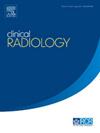Identification of image quality degradation factors in abdominal free-breathing dynamic contrast-enhanced magnetic resonance imaging (MRI)
IF 1.9
3区 医学
Q2 RADIOLOGY, NUCLEAR MEDICINE & MEDICAL IMAGING
引用次数: 0
Abstract
AIM
To identify the image quality degradation factors (IQDF), which can be obtained precontrast in abdominal free-breathing dynamic contrast-enhanced magnetic resonance imaging (FB-DCEMRI).
MATERIALS AND METHODS
This retrospective study enrolled patients who underwent abdominal FB-DCEMRI. The patients' demographics and underlying diseases at the time of MRI were recorded. Two radiologists assessed the precontrast and arterial phase images and assigned the confidence scores for motion artifact, streak artifact, and overall image quality using a 5-point Likert scale. Acceptable image quality was defined as ≥3 points in the overall image quality at the arterial phase. Based on this assessment, patients were classified into two groups: acceptable and nonacceptable groups. The IQDF were identified through logistic regression analysis.
RESULTS
Among the 73 patients, 48 (66%) were included in the acceptable group, while 25 (34%) were included in the unacceptable group. Only the prevalence of cirrhosis was different between the two groups (4% vs 20% in the acceptable and unacceptable groups; P = .04). All the confidence scores were higher in the acceptable group than in the unacceptable group (P < .001–.007). Only cirrhosis (P = .03) and overall image quality at precontrast (P = .02) were identified as the IQDF. Furthermore, using the fitted logistic regression equation, the sensitivity, specificity, and area under the curve for predicting unacceptable image quality were 56% [14/25], 92% [44/48], and 0.79 [95% confidence interval, 0.68–0.87], respectively.
CONCLUSION
The presence of cirrhosis and unacceptable image quality at precontrast were identified as the IQDF based on the findings of the abdominal FB-DCEMRI.
腹部自由呼吸动态磁共振成像(MRI)图像质量退化因素的识别
目的确定腹部自由呼吸动态对比增强磁共振成像(FB-DCEMRI)预对比中图像质量退化因子(IQDF)。材料和方法本回顾性研究纳入了接受腹部FB-DCEMRI的患者。记录患者MRI时的人口统计学特征和基础疾病。两名放射科医生评估了对比前和动脉期图像,并使用5分李克特量表分配了运动伪影、条纹伪影和整体图像质量的置信度分数。可接受的图像质量定义为动脉期整体图像质量≥3分。在此基础上,将患者分为两组:可接受组和不可接受组。通过逻辑回归分析确定了IQDF。结果73例患者中,可接受组48例(66%),不可接受组25例(34%)。两组之间只有肝硬化的患病率不同(可接受组和不可接受组分别为4%和20%;P = .04)。可接受组的所有信心得分均高于不可接受组(P <;措施-.007)。只有肝硬化(P = .03)和对比度前的整体图像质量(P = .02)被确定为IQDF。此外,使用拟合的logistic回归方程,预测不可接受图像质量的灵敏度,特异性和曲线下面积分别为56%[14/25],92%[44/48]和0.79[95%置信区间,0.68-0.87]。结论根据腹部FB-DCEMRI的检查结果,肝硬化的存在和对比度前图像质量不可接受被确定为IQDF。
本文章由计算机程序翻译,如有差异,请以英文原文为准。
求助全文
约1分钟内获得全文
求助全文
来源期刊

Clinical radiology
医学-核医学
CiteScore
4.70
自引率
3.80%
发文量
528
审稿时长
76 days
期刊介绍:
Clinical Radiology is published by Elsevier on behalf of The Royal College of Radiologists. Clinical Radiology is an International Journal bringing you original research, editorials and review articles on all aspects of diagnostic imaging, including:
• Computed tomography
• Magnetic resonance imaging
• Ultrasonography
• Digital radiology
• Interventional radiology
• Radiography
• Nuclear medicine
Papers on radiological protection, quality assurance, audit in radiology and matters relating to radiological training and education are also included. In addition, each issue contains correspondence, book reviews and notices of forthcoming events.
 求助内容:
求助内容: 应助结果提醒方式:
应助结果提醒方式:


